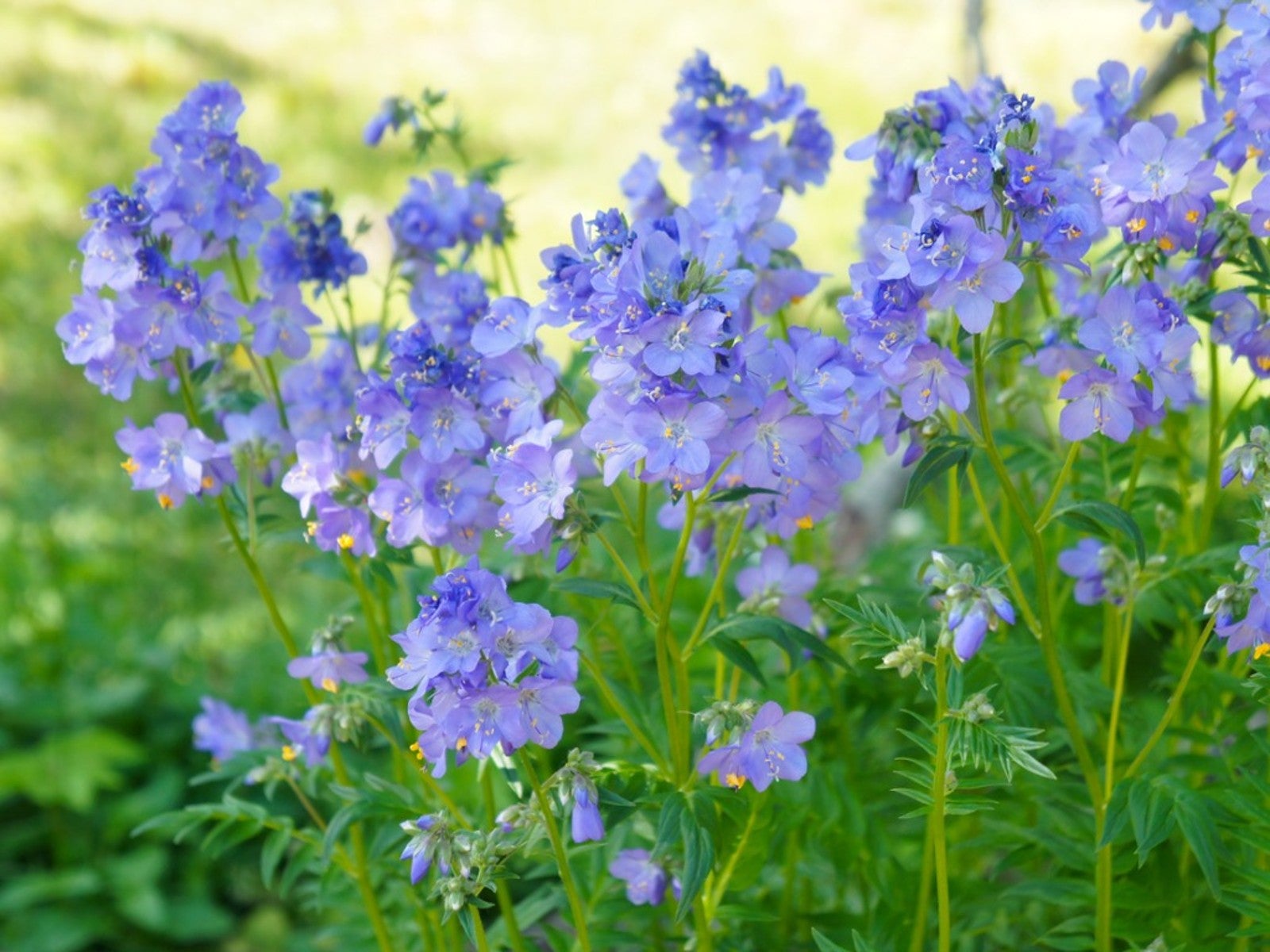In the quiet corners of a garden, where shade meets light and foliage meets flower, Jacob’s Ladder offers a refined beauty. Its feathery, evenly spaced leaflets give the plant its common name, as they resemble the biblical ladder stretching skyward. This perennial has a gentle presence, thriving in woodland settings or shaded borders where subtlety is welcome.
Often chosen for its early blooms and delicate texture, Jacob’s Ladder brings cool blues, purples, or even white flowers to spring gardens. It is also low maintenance and deer-resistant, making it a dependable addition to landscapes that favor a more naturalistic or cottage-style design.

Portrait of the Jacob’s Ladder
Jacob’s Ladder belongs to the Polemoniaceae family and is native to Europe and parts of Asia. The most commonly cultivated species, Polemonium caeruleum, forms tidy mounds of finely divided foliage and upright stems topped with bell-shaped flowers in spring and early summer.
Its elegant structure and soft blooms make it a versatile perennial for shaded gardens, particularly when paired with ferns, hostas, or astilbes.
Foliage and Form
Jacob’s Ladder stands out for its symmetrical, ladder-like leaves, which consist of pairs of leaflets arranged along a central stem. The foliage is usually a rich green, although some varieties may offer variegation or purple tinges.
- Height: 30–60 cm (1–2 ft)
- Spread: 30–45 cm (1–1.5 ft)
- Form: Clumping, upright growth
Blooms and Fragrance
The flowers rise above the foliage on tall stems, featuring clusters of soft, nodding, bell-shaped blossoms in hues of blue, purple, pink, or white.
- Bloom Time: Mid to late spring; may rebloom lightly
- Color: Blue, violet, pink, white
- Fragrance: Lightly scented, often described as fresh or sweet
The Right Time to Plant and Care for Jacob’s Ladder
Jacob’s Ladder should be divided every few years to maintain its vigor. Deadheading can promote a second, lighter bloom in some climates.
| Month | Planting | Flowering | Pruning |
|---|---|---|---|
| January | ❌ | ❌ | ❌ |
| February | ✅ (indoors, from seed) | ❌ | ❌ |
| March | ✅ (early, outdoors or hardened seedlings) | ❌ | ✅ (clean dead leaves) |
| April | ✅ | ✅ (start) | ✅ (deadhead spent blooms) |
| May | ✅ | ✅ | ✅ |
| June | ❌ | ✅ (light rebloom) | ✅ |
| July | ❌ | ✅ (reblooming) | ✅ |
| August | ❌ | ❌ | ✅ |
| September | ✅ (for fall root establishment) | ❌ | ✅ |
| October | ✅ | ❌ | ✅ |
| November | ❌ | ❌ | ✅ |
| December | ❌ | ❌ | ❌ |
✅ = Recommended ❌ = Not advised
Watering, Sunlight, Indoor vs Outdoor, and Temperature
Watering
Jacob’s Ladder enjoys consistently moist, well-drained soil, particularly during the growing season.
- Water regularly, especially during dry periods.
- Avoid allowing the soil to dry out completely or become waterlogged.
Sunlight
This plant performs best in partial shade, although it can tolerate morning sun in cooler regions.
- In hot climates, ensure it receives afternoon shade to avoid leaf scorch.
- Too much sun may reduce bloom duration.
Indoor vs Outdoor
Jacob’s Ladder is primarily grown outdoors, especially in shaded garden beds or woodland-style borders.
- Not well-suited for indoor growing due to its height and humidity needs.
- Can be started indoors from seed in late winter for transplanting.
Temperature
- Hardiness: USDA Zones 3–8
- Ideal Range: 10–24°C (50–75°F)
- Heat Sensitivity: Can suffer in hot, humid climates if not well shaded
Ideal Soil Conditions for Growing Jacob’s Ladder
| Soil Feature | Optimal Condition | Why It Matters |
|---|---|---|
| Soil Type | Loamy, rich in organic matter | Provides nutrients and retains even moisture |
| Texture | Soft and crumbly | Encourages healthy root spread |
| Drainage | Well-drained | Prevents root rot and mildew |
| Moisture | Evenly moist | Ensures lush growth and prolonged blooming |
| Soil pH | Neutral to slightly acidic (6.0–7.0) | Supports overall plant health and flowering |
Common Problems & Solutions
| Issue 🐾 | Symptoms 🔍 | Solutions 🛠️ |
|---|---|---|
| Powdery Mildew 🌫️ | White film on leaves | Improve air circulation, avoid overhead watering |
| Leaf Scorch 🔥 | Brown leaf edges | Increase shade, ensure adequate water |
| Slugs & Snails 🐌 | Chewed leaves, slime trails | Use organic deterrents or barriers |
| Weak Growth 🍃 | Sparse foliage, fewer flowers | Divide clumps every few years, fertilize lightly |
Graceful, hardy, and subtly colorful, Jacob’s Ladder is a rewarding choice for gardeners seeking texture and elegance in partially shaded or woodland spaces. With minimal fuss and a soft, natural look, it’s a dependable performer that brings gentle vibrancy to spring and early summer gardens.